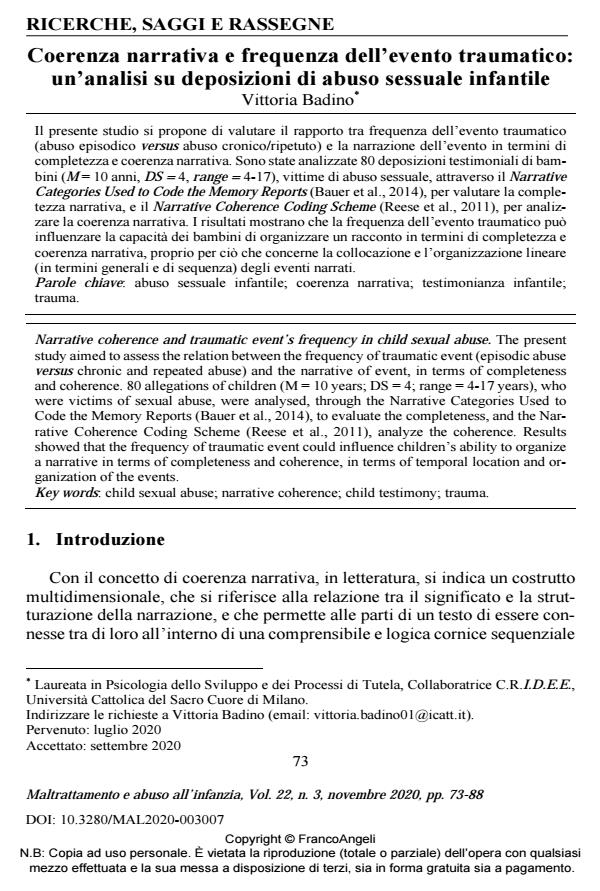Coerenza narrativa e frequenza dell’evento traumatico: un’analisi su deposizioni di abuso sessuale infantile
Titolo Rivista MALTRATTAMENTO E ABUSO ALL’INFANZIA
Autori/Curatori Vittoria Badino
Anno di pubblicazione 2021 Fascicolo 2020/3
Lingua Italiano Numero pagine 16 P. 73-88 Dimensione file 250 KB
DOI 10.3280/MAL2020-003007
Il DOI è il codice a barre della proprietà intellettuale: per saperne di più
clicca qui
Qui sotto puoi vedere in anteprima la prima pagina di questo articolo.
Se questo articolo ti interessa, lo puoi acquistare (e scaricare in formato pdf) seguendo le facili indicazioni per acquistare il download credit. Acquista Download Credits per scaricare questo Articolo in formato PDF

FrancoAngeli è membro della Publishers International Linking Association, Inc (PILA)associazione indipendente e non profit per facilitare (attraverso i servizi tecnologici implementati da CrossRef.org) l’accesso degli studiosi ai contenuti digitali nelle pubblicazioni professionali e scientifiche
Il presente studio si propone di valutare il rapporto tra frequenza dell’evento traumatico (abuso episodico versus abuso cronico/ripetuto) e la narrazione dell’evento in termini di completezza e coerenza narrativa. Sono state analizzate 80 deposizioni testimoniali di bam-bini (M = 10 anni, DS = 4, range = 4-17), vittime di abuso sessuale, attraverso il Narrative Categories Used to Code the Memory Reports (Bauer et al., 2014), per valutare la comple-tezza narrativa, e il Narrative Coherence Coding Scheme (Reese et al., 2011), per analizzare la coerenza narrativa. I risultati mostrano che la frequenza dell’evento traumatico può in-fluenzare la capacità dei bambini di organizzare un racconto in termini di completezza e coe-renza narrativa, proprio per ciò che concerne la collocazione e l’organizzazione lineare (in termini generali e di sequenza) degli eventi narrati.
Parole chiave:Abuso sessuale infantile; coerenza narrativa; testimonianza infantile; trauma.
- Narrative coherence and emotion regulation in children exposed to Adverse Childhood Experiences Eleonora Bartoli, in MALTRATTAMENTO E ABUSO ALL'INFANZIA 1/2022 pp.11
DOI: 10.3280/MAL2022-001002 - Completezza e coerenza narrativa in bambini sessualmente abusati: il ruolo dell'età e del PTSD Sarah Miragoli, Vittoria Badino, Elena Camisasca, in MALTRATTAMENTO E ABUSO ALL'INFANZIA 1/2022 pp.33
DOI: 10.3280/MAL2022-001003
Vittoria Badino, Coerenza narrativa e frequenza dell’evento traumatico: un’analisi su deposizioni di abuso sessuale infantile in "MALTRATTAMENTO E ABUSO ALL’INFANZIA" 3/2020, pp 73-88, DOI: 10.3280/MAL2020-003007